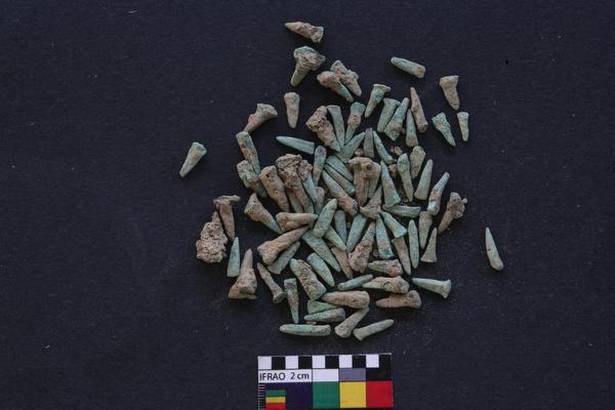Sanauli
(Created page with "{| class="wikitable" |- |colspan="0"|<div style="font-size:100%"> This is a collection of articles archived for the excellence of their content.<br/> Additional information ma...") |
(→India’s largest known ancient burial site) |
||
| Line 12: | Line 12: | ||
=India’s largest known ancient burial site= | =India’s largest known ancient burial site= | ||
| − | [https:// | + | [https://timesofindia.indiatimes.com/india/indias-largest-known-burial-site-is-3800-yrs-old-confirms-carbon-dating/articleshow/74254040.cms Rohan Dua, February 22, 2020: ''The Times of India''] |
| − | [[File: Sanauli- India's largest known ancient burial site.jpg|Sanauli: India's largest known ancient burial site <br/> From: [https:// | + | |
| + | [[File: Sanauli- India's largest known ancient burial site.jpg|Sanauli: India's largest known ancient burial site <br/> From: [https://timesofindia.indiatimes.com/india/indias-largest-known-burial-site-is-3800-yrs-old-confirms-carbon-dating/articleshow/74254040.cms Rohan Dua, February 22, 2020: ''The Times of India'']|frame|500px]] | ||
Carbon dating tests have confirmed that India’s largest known necropolis in UP’s Sanauli — where 126 burials have been discovered until now — is 3,800 years old. The elaborate burials, which included underground chambers, decorated legged coffins and rice in pots buried with the bodies, belong to an indigenous warrior tribe which inhabited the region, according to the Archaeological Survey of India. | Carbon dating tests have confirmed that India’s largest known necropolis in UP’s Sanauli — where 126 burials have been discovered until now — is 3,800 years old. The elaborate burials, which included underground chambers, decorated legged coffins and rice in pots buried with the bodies, belong to an indigenous warrior tribe which inhabited the region, according to the Archaeological Survey of India. | ||
| Line 61: | Line 62: | ||
[[File: A heap of 2-cm-long copper nails..jpg|A heap of 2-cm-long copper nails. <br/> Photo: Archaeological Survey of India <br/> From: [https://frontline.thehindu.com/arts-and-culture/heritage/article24923891.ece/photo/3/ T.S. SUBRAMANIAN, ''The Hindu'']|frame|500px]] | [[File: A heap of 2-cm-long copper nails..jpg|A heap of 2-cm-long copper nails. <br/> Photo: Archaeological Survey of India <br/> From: [https://frontline.thehindu.com/arts-and-culture/heritage/article24923891.ece/photo/3/ T.S. SUBRAMANIAN, ''The Hindu'']|frame|500px]] | ||
| + | |||
| + | [[Category:History|S | ||
| + | SANAULI]] | ||
| + | [[Category:India|S | ||
| + | SANAULI]] | ||
| + | [[Category:Pages with broken file links|SANAULI]] | ||
| + | [[Category:Places|S | ||
| + | SANAULI]] | ||
Latest revision as of 08:51, 7 August 2022
This is a collection of articles archived for the excellence of their content. |
[edit] India’s largest known ancient burial site
Rohan Dua, February 22, 2020: The Times of India

From: Rohan Dua, February 22, 2020: The Times of India
Carbon dating tests have confirmed that India’s largest known necropolis in UP’s Sanauli — where 126 burials have been discovered until now — is 3,800 years old. The elaborate burials, which included underground chambers, decorated legged coffins and rice in pots buried with the bodies, belong to an indigenous warrior tribe which inhabited the region, according to the Archaeological Survey of India.
Excavations in Sanauli, 68 km from Delhi in UP’s Baghpat, began in 2005 and resumed in 2018, leading to discovery of horse-drawn chariots, burials, four-legged wooden coffins, pottery, a copper antenna sword and war shields. ASI joint director S K Manjul, who led the excavations, told TOI carbon dating has confirmed the burials date back to 1,900 BC, with a margin of 300 years.
Between ’05-06, 116 burials were discovered
Between 2005 and 2006, 116 burials were found while 10 more were discovered in the last two years, making it India’s largest known necropoli,.” Manjul said. The burial pits had legged coffins along with systematically arranged vases, bowls and pots. One of the coffins was decorated with eight anthropomorphic figures.
A recent report submitted by the Birbal Sahni Institute of Paleosciences in Lucknow to the ASI had said that there are two C-14 (carbon dating) dates — 3815 and 3500, with a margin of error of 130 years — for the Sanauli site. It added, “Carbon dating marks this site as an earliest history of a warrior tribe in the Indian subcontinent (sic).”
While the Deccan College, Pune, and a lab in Hyderabad conducted DNA tests of the human remains, samples were also sent to the Lucknow institute. Scientific techniques such as photogrammetry and ground penetrating radar survey were used while drones and magnetometers were also deployed.
[edit] Details

Photo: Archaeological Survey of India
From: T.S. SUBRAMANIAN, The Hindu

Photo: Archaeological Survey of India
From: T.S. SUBRAMANIAN, The Hindu

Photo: Archaeological Survey of India
From: T.S. SUBRAMANIAN, The Hindu

Photo: Archaeological Survey of India
From: T.S. SUBRAMANIAN, The Hindu

Photo: Archaeological Survey of India
From: T.S. SUBRAMANIAN, The Hindu

Photo: Archaeological Survey of India
From: T.S. SUBRAMANIAN, The Hindu

Photo: T.S. Subramanian
From: T.S. SUBRAMANIAN, The Hindu

Photo: T.S. Subramanian
From: T.S. SUBRAMANIAN, The Hindu

Photo: Archaeological Survey of India
From: T.S. SUBRAMANIAN, The Hindu

Photo: Archaeological Survey of India
From: T.S. SUBRAMANIAN, The Hindu

Photo: T.S. Subramanian
From: T.S. SUBRAMANIAN, The Hindu

Photo: Archaeological Survey of India
From: T.S. SUBRAMANIAN, The Hindu

Photo: T.S. Subramanian
From: T.S. SUBRAMANIAN, The Hindu

Photo: Archaeological Survey of India
From: T.S. SUBRAMANIAN, The Hindu

Photo: Archaeological Survey of India
From: T.S. SUBRAMANIAN, The Hindu